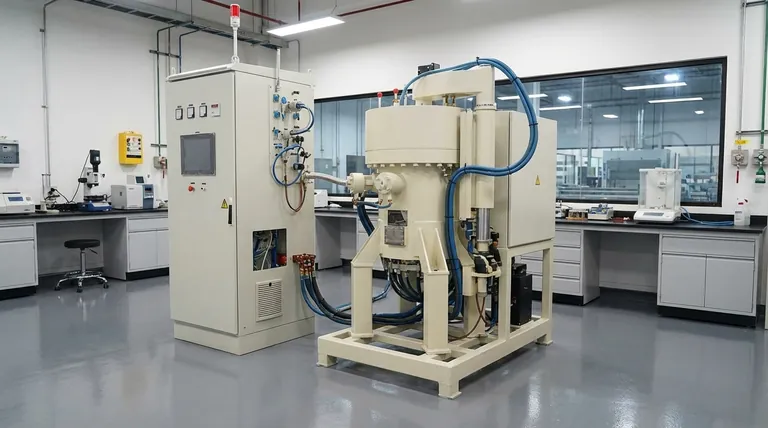In short, a vacuum sintering furnace can range from approximately $55,000 to over $200,000. This wide variation exists because a "sintering furnace" is not a single product but a category of highly specialized equipment. The final price is determined by its size, maximum temperature, and its ability to control the internal atmosphere.
The question isn't just "how much does a furnace cost," but rather "which furnace capabilities do I need to pay for?" The final price is a direct reflection of your specific material requirements and production scale.

What Drives the Cost of a Sintering Furnace?
The price of a sintering furnace is not arbitrary. It is a direct calculation based on the engineering challenges associated with achieving and maintaining specific conditions of temperature, atmosphere, and scale.
Scale: From Lab Bench to Factory Floor
The most visible cost factor is the size of the furnace's usable hot zone. A larger chamber requires more raw materials, more powerful heating elements, and a more robust frame.
Small, benchtop furnaces used for dental labs or research and development have a much lower entry price. Large, industrial-scale furnaces designed for high-volume manufacturing command the highest prices due to the sheer scale of their construction and power requirements.
Temperature: The Energy Demand
Higher temperatures are exponentially harder and more expensive to achieve and contain. The materials required for heating elements and insulation change dramatically as you increase the target temperature.
A furnace rated for 1200°C is fundamentally simpler than one designed to reach 1700°C or higher. The latter requires more exotic (and expensive) heating elements, advanced refractory materials, and sophisticated cooling systems to protect the furnace shell.
Atmosphere: Controlling the Environment
This is often the most significant cost driver. The complexity of the system used to control the gas environment inside the furnace dictates the price.
- Air Furnaces: The simplest and least expensive, these operate in ambient air.
- Inert Gas Furnaces: These require systems to purge oxygen and backfill with gases like argon or nitrogen, adding cost for plumbing, sensors, and controls.
- Vacuum Furnaces: Requiring vacuum pumps, robust seals, and a chamber capable of withstanding negative pressure, these are significantly more complex and costly. The level of vacuum (e.g., rough vs. high vacuum) also impacts the price.
Control and Automation: Precision and Repeatability
The sophistication of the control system is a key factor. A basic controller that simply follows a temperature profile is standard.
However, advanced systems with programmable logic controllers (PLCs), sophisticated data logging for quality control, remote operation, and automated safety interlocks add considerable cost. These features are critical for validated processes in industries like medical or aerospace.
Understanding the Trade-offs
Choosing a furnace involves balancing upfront investment against long-term operational success. A myopic focus on the initial sticker price can lead to significant downstream costs.
Upfront Cost vs. Operating Cost
A less expensive furnace may have poorer insulation or less efficient heating elements. This results in higher electricity consumption for every cycle, potentially costing far more than the initial savings over the furnace's lifetime.
Feature Creep: Paying for Unused Capability
It can be tempting to purchase a furnace with the highest possible temperature rating or the most complex atmospheric controls. However, if your process only requires 1500°C, paying a premium for a 1700°C furnace is a waste of capital.
Maintenance and Consumables
Every furnace has components with a finite life. Higher-performance furnaces often use more specialized—and expensive—consumables like heating elements, thermocouples, and vacuum seals. These long-term maintenance costs must be factored into the total cost of ownership.
Making the Right Choice for Your Application
To select the right furnace, you must first define your primary objective.
- If your primary focus is research and development: Prioritize a furnace with a versatile temperature range and flexible atmospheric controls over sheer size.
- If your primary focus is high-volume, repeatable production: Invest in automation, robust controls, and energy efficiency to minimize cost-per-part and ensure quality.
- If your primary focus is processing advanced materials: The maximum temperature and purity of the atmosphere are non-negotiable, making them the primary drivers of your selection.
Ultimately, defining your process requirements with precision is the most effective way to manage the cost of your investment.
Summary Table:
| Cost Factor | Impact on Price | Key Considerations |
|---|---|---|
| Size / Scale | Higher | Benchtop (R&D) vs. Industrial (Production) |
| Max Temperature | Higher | 1200°C (standard) vs. 1700°C+ (exotic materials) |
| Atmosphere Control | Higher | Air (lowest) < Inert Gas < Vacuum (highest) |
| Automation & Controls | Higher | Basic controllers vs. advanced PLCs with data logging |
Ready to find the perfect sintering furnace for your lab's needs and budget?
At KINTEK, we specialize in providing lab equipment and consumables tailored to your specific material requirements and production scale. Whether you're in R&D or high-volume manufacturing, our experts will help you select a furnace that balances upfront cost with long-term efficiency and reliability.
Contact us today for a personalized consultation and quote!
Visual Guide

Related Products
- Vacuum Heat Treat and Sintering Furnace with 9MPa Air Pressure
- 1400℃ Laboratory Quartz Tube Furnace with Alumina Tube Tubular Furnace
- 1700℃ Controlled Atmosphere Furnace Nitrogen Inert Atmosphere Furnace
- Molybdenum Vacuum Heat Treat Furnace
- 2200 ℃ Graphite Vacuum Heat Treat Furnace
People Also Ask
- What is the impact factor of powder metallurgy progress? A 2022 Analysis & Context
- What temperature does tungsten carbide sinter at? Master the 1350°C-1500°C Liquid-Phase Sintering Process
- What are the advantages of vacuum sintering? Achieve Superior Purity, Strength, and Performance
- What are the different versions of sintering? Choose the Right Process for Your Material
- What are the main advantages of vacuum sintering? Achieve Superior Purity and Performance



















